
Maximize the yield of potato in a micro plot of 3 x 3 feet.
- Which varieties work best in your garden?
- Which varieties find the best use in your kitchen?
- Which store best without refrigeration?
- It's all about finding the correct varieties for optimal vertical growth in a potato box.
We believe that you can increase your yield (perhaps up to 99 pounds) in such a small area if the vines are grown in a container, raise the container as the vines grow taller. You need the optimal potato varieties and healthy seed.
Potato are cheap! Why grow garden potato?
True, field potato are cheap (valued at 20 cents a pound) ... but potato tubers are like sponges! You really want garden potatoes, grown without chemicals, with edible peals. The benefits of eating potatoes with the peals include more fibers, higher trace elements, higher anti-oxydants (up to 90 times more), anti cancer enzymes. Organic garden potato can fetch up to $5 a pound at farmer's markets. Grow your own and save a lot!
Click here to read more about the health benefits of potato.
This is the yield promised from a 9 square feet area. The container is assembled as the vines grow. You need to keep adding soil (mixed with compost and leaves) as soon as the vines grow out.
If you leave the vines exposed to the light for too long, they will stop growing stolons (the root system that connects the tubers to the vine).
Notice how this first wood plank is secured to the posts. The next plank will have the same size and settings. At the end of the season one whole container side can be removed to harvest the crop.
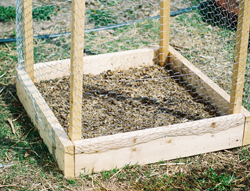
These pictures were taken on June 28th - in the next few days I'll be ready to add the second layer of salvage lumber and add in more compost, soil, leaves, straw ....
In 2009 I have tested the yields of two different potato cultivars (Gurney's Everbearing and Irish Treasure). The top picture I'm facing south - Irish Treasure is on the right side, while in the bottom picture I'm facing north and Gurney's Everbearing is on the right side. Notice how the GE vines are a little shorter.
It is important to match vines with the same vine growth habits, if you wish to grow several varieties in one box.
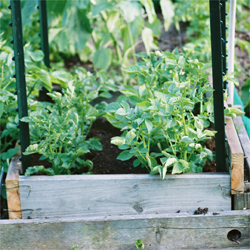
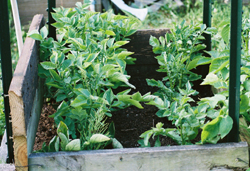
Found no tubers growth above the original soil line. A very small yield even compared to the standard growing method (6" furrow). I've started this first test later in the season and grabbed whatever seed I had available. The selection of good and healthy seed tubers is paramount for a succesful harvest.
Heritage Potato Variety Selection
Better results can be expected with a potato cultivar which keeps setting tubers through the growing season. You can define the search for an "opportunistic" cultivar in the Kenosha Potato Project varieties catalog. If you grow two or more varieties in one container, it is paramount to select cultivars with similar vine growth habits. Also search for Tall Vines.
To optimally time the harvesting, it is best to mix varieties with the same expected maturity. Don't mix an early variety with a late one.
Finally, in your variety selection, we guess that cultivars that feature Tall Vines growth will perform better. Heritage varieties may work better because the modern agri-industry has selected varieties that don't grow very tall (long vines would tangle the harvesting equipment).
The challenge to grow 99 pounds of potato tubers in a micro plot is bound to the correct seed selection. Seed piece density may also play a role.
Usually potato seed pieces are placed in the field furrows with spacing of 12 - 18", while in the potato box we are suggesting to use a much higher density. Try to space 4 - 6" in a row. In a 36" wide box you may want to test 2 and 3 rows.
For 2010 I've kept records of varieties that grow shallow tubers on long vines - plus varieties that produce larger crops.
2009 best producers (in traditional furrow - great potential for container growth) are:
- Blue Goose (3 seed pieces produced 11 pounds 13 oz) mostly large oblong tubers
- Up to Date (3 seed pieces produced 11 pounds 6 oz) mostly lumpy tubers
- Russian Banana (3 seed pieces produced 9 pounds 14 oz) medium fingerlings
- Batoche (3 seed pieces produced 8 pounds) mostly large round tubers
- Calico (3 seed pieces produced 7 pounds) mostly large, tapered tubers
- Kemerowski (3 seed pieces produced 7 pounds) mostly large tubers
- Mountain Rose (3 seed pieces produced 7 pounds) mostly large tubers
- Eersteling (3 seed pieces produced 6 pounds 14 oz.) in a size mix - matches Mt Rose as an early maturing variety
- Fortyfold (3 seed pieces produced 5 pounds 9 oz) many, mostly small, round tubers
- Dutch Blue (3 seed pieces produced 5 pounds 3 oz) many small, round tubers
- Papa Chonca (3 seed pieces produces 4 pounds 6oz) medium-small blue fingerlings - this yield is not impressive, but the vine is very late and the tuber set is shallow on long stolons
- Elmer's Blue (2 in-vitro seedlings produced 2 pounds 4 oz) - obviously a variety that needs further testing grown from tuber seed pieces - but the harvest from in-vitro seedling was really impressive - I observed long stolons and shallow tuber setting ... but most interestingly I counted 80 tubers in bite size or larger and 32 additional in pea size.

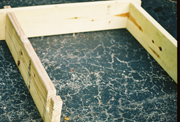
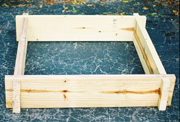
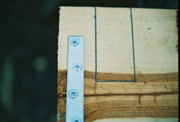
- Cut 2 x 8 boards to 36" lenght
- Rip 3" 5/8 on both ends
- Assemble 4 boards into one box
- Build more boxes for higher vine growth
- At season end the box can be disassembled for easy storage
This solution may NOT work well with varieties that grow tall vines - the smaller size of the bin will not meet the 99 pound challenge! But you may be able to grow 10 - 15 pounds without digging.